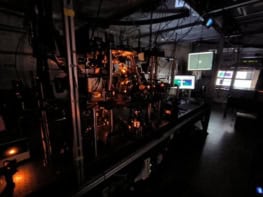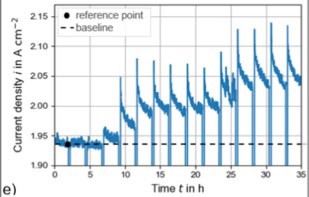Despite humans having seemingly “tamed” fire many millennia ago, there are still lots of open questions when it comes to the physics of wildfires, as Stephen Ornes discovers
Robert Kremens fights fire with fire. No, really – that’s his job. Kremens sets fires in a host of locations across the US. In April he drove 18 hours from his home in Rochester, New York, to Tall Timbers, a research station in Tallahassee, Florida, to set three or four fires. In mid-May he travelled to Wisconsin with the US Fire Service, again setting blazes, keeping his distance and watching how they burned. This summer, he’s back in New York, setting more fires closer to home. Most of us break up the year by months, seasons or semesters; for Kremens, it’s divided by his burning schedule.
Kremens, a physicist and a trained firefighter, also seeks out fires he didn’t set. On 31 July 2015 lightning struck a tree a few miles north of Hume Lake in central California’s rugged Sierra National Forest, igniting a devastating forest fire that raged for weeks, ultimately consuming more than 600 km2. The blaze, named the Rough Fire, began in a steep and hard-to-reach area and climbed uphill, boosted by the warm, windy, dry conditions. Most people at the time avoided the location. But a week after it broke out, Kremens caught a plane from New York to California to join a fire-monitoring team with the goal of measuring and analysing the wildfire in real time. They weren’t there to fight the fire; they were there to understand it.
For three days, they cleared branches and converted nearly 20 small, unspoiled forest plots into impromptu laboratories. They installed cameras and other sensors that could take measurements of the blaze. With any luck – and this is a strange sort of luck – these small clearings would lie in the fire’s path and collect data as it burned through. After the fire was gone, the researchers returned to their investigation sites and found that 12 had been burned and two others lay in unburned islands, still within the area of the fire. Those data would be used by the Missoula Fire Sciences Laboratory in Montana – one of the world’s leading wildfire research centres – to learn more about fire properties such as heat transfer and how different materials ignite.
Fires are unpredictable, and fire research is riddled with open questions. Much of the physics of how a fire spreads is still a mystery, and researchers struggle to predict how long a given material will burn, or how much energy it will release. Also, researchers don’t know exactly how heat and mass move within or in front of a fire to ignite new material and spread the blaze. Dead sticks and grass burn easily, which can be explained by their lack of moisture. But scientists don’t know why the small green needles on living conifers also burn easily – and fuel the biggest, most destructive wildfires, which tear through the crowns, or tops, of living trees. Because forest fires devour a mix of living and dead vegetation, understanding how things burn is critical to figuring out how to protect people and property.
Chasing these questions, scientists have found a way to search for answers, which is – paradoxically – to set more fires.
Prescribed burns
Kremens’ work with fire began in 2000, after a destructive fire season prompted the Rochester Institute of Technology, where he is based, to establish a fire research programme. Since then, he’s led an effort to investigate combustion in wildfire. He’s also trained as a structural firefighter in Rochester, which means he responds to house fires and other alarms around the city. His goal in fire research is to develop portable, inexpensive and fireproof instruments that can be laid in a fire’s path to measure its convective and radiative power. Kremens also participates in intentional “prescribed burns”, offering advice on when, where and how long to burn for. But despite his decades of experience, extensive knowledge of fire and encounters with hundreds of blazes, he still gets a little nervous. “Every time there’s a fire on the ground, I’m a little panicked,” he admits. “It’s natural to be scared shitless when there’s a fire going on.”
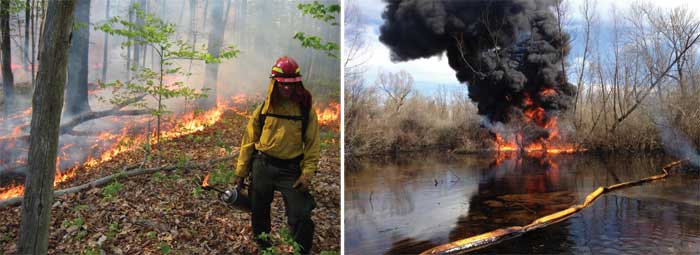
Wildfires are inevitable, but the last few years have witnessed waves of destructive, with widespread wildfires that have caused billions in damage around the world. A 2013 study suggests large forest fires are becoming more frequent and are posing a greater threat to people and property, in part because people are moving into fire-prone areas and building structures there. Firefighters and researchers have made progress in understanding the fires that bring down buildings and other structures, says Michael Gollner, who leads a research group in the University of Maryland’s Department of Fire Protection Engineering, in College Park. The increased use of sprinklers and less-flammable building materials have helped reduce structural risks.
But fires that burn outside are a different story. They’re more complicated, and the result of myriad environmental factors, not all of which are easy to study. “Usually there’s a natural cycle to burning,” says Gollner. “If you miss that cycle – let’s say because humans continually put out those fires – then the problem doesn’t go away. It gets worse.” That’s the unsettling paradox at the heart of wildfire management – without small fires to clear debris from the forest floor, he says, dead sticks and leaves lie in wait, ready to burst into flame under the right conditions. Once the fire gets large enough, it can spread to the trees’ crowns and form walls of flame 30 m tall. To avoid wild, out-of-control fires, Gollner says researchers need to think about ways to reduce stores of fuel. Small, intentional burns can lower fire intensity.
Kremens agrees. For nearly a century, he says, “we’ve been suppressing fires, and it’s caused a tremendous abundance of fuel on the ground. How do you reduce those fuels without endangering the population and wrecking everything?” In New Jersey’s Pine Barrens, for example, he works with the Forest Service to find optimal times of year and weather conditions for burning away debris. Otherwise, “we risk starting a fire that we can’t control, and then we burn New Jersey down”, he says. “Some people wouldn’t mind that, but it is an incredibly beautiful state.”
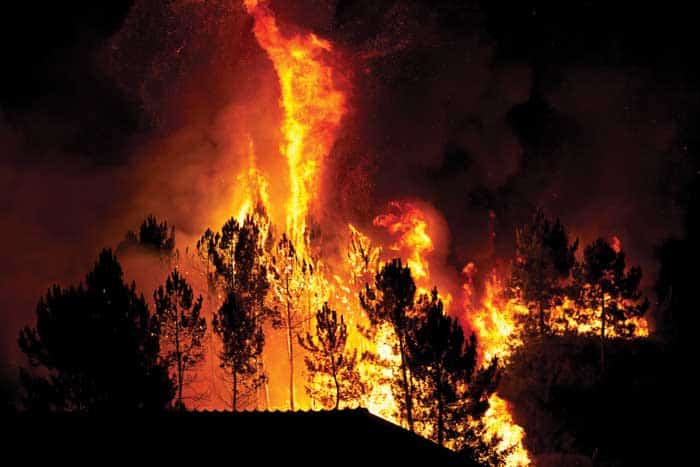
These prescribed burns serve another important role: as experimental testing grounds to probe the inner physical structures of fires. In addition to conducting outdoor prescribed burns, researchers at the Missoula Laboratory study how fires start and spread using indoor experiments in wind tunnels and a burn chamber. They control the types and arrangements of materials, and analyse how those materials burn. Recent experiments have begun to identify surprising avenues for energy transfer, as well as structures within the fire itself. The complexity of those structures, however, is daunting.
Experimental burning has provided the data behind many national fire warning systems, including those used in Australia and Canada, and some countries in Europe, according to Mark Finney, a researcher at Missoula. At the same time, it’s shown that fire research, despite decades of work, is still in its infancy. “We’re just at the stage of recognizing the problems,” he says. “We haven’t really realized what our basic informational needs are.”
Primary ingredients
Finney ticks off three primary ingredients for a fire. First is combustion, which is the chemical reaction of a fuel with oxygen that results in glowing, flaming, and heat release. Then there’s a transfer of energy, as by radiation (the release of heat) or convection (the movement of hot gases or fluids). The third ingredient is the ignition of new fuels that are encountered by the released energy. “Those each have open questions associated with them that are basic in nature,” says Finney.
Recent studies at Missoula have started to crack open some of fire’s physics mysteries. One of the biggest, in recent years, is the role of convection. Since fire research began in earnest more than 70 years ago, scientists have largely assumed that radiation was the most important factor in spreading a fire. The idea was that combustion produced radiant energy, which heated and ignited new fuel. “Nobody had ever studied flame structure before,” says Finney. And why would they have? If radiation – a clean and simple phenomenon – suffices as an explanation, then why bother with convection?
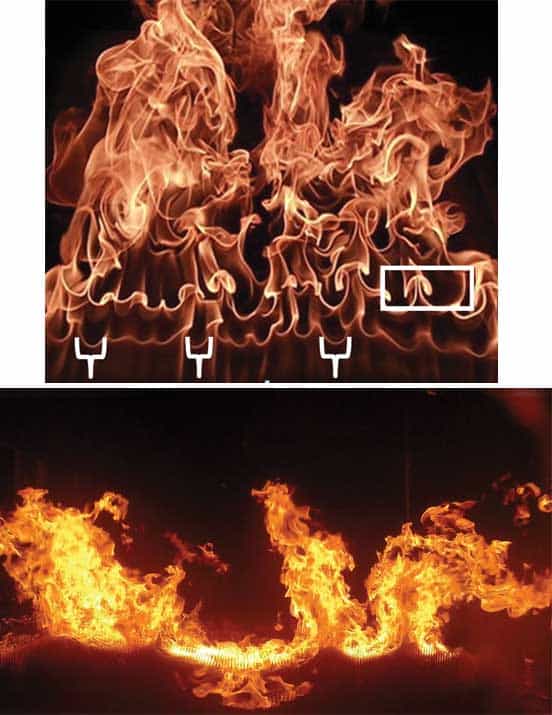
But the assumption that radiation would suffice hit a snag when Finney and other researchers began reporting on experiments showing that radiation is not sufficient. Small particles of fuel failed to ignite when exposed to radiation at levels equivalent to those from a forest fire, which in turn led researchers to look at whether convection played a significant role (2015 PNAS 112 9833). Detailed experiments using high-speed cameras revealed structures lurking within the fire. Imaging revealed vortex pairs rotating in opposite directions, forcing flames into patterns of upward-pointing peaks and lower troughs. These vortices looked familiar – in fluid dynamics, they’re known as “Taylor–Görtler vortex pairs” and they arise when a turbulent fluid encounters a concave boundary. The vortices help explain the bright streaks that are often observed in fires (figure 1).
Finney and his team also found that the vortices could explain a phenomenon that’s been observed since the 1960s, in which powerful bursts of flame sometimes surge out of a leading edge of a fire and engulf the surrounding environment. In small fires, that surge may be only a few inches; in large crown fires, it may produce flame bursts many tens of metres long. Such bursts can be deadly, especially to the brave firefighters trying to control a wild blaze. Their study suggests that convection, rather than radiation, is the secret ingredient (or just one of them) to pushing a fire forward, but they’ll need to run more experiments at larger scales to see if that conclusion holds.
Back to basics
Studies like the ones of convection, says Kremens, show how fire science is returning to the basic principles of combustion to try to understand how a fuel bed ignites. “The field is opening up as people go back to basic physics principles,” he says. Wildfires are inevitable, adds Finney. The ultimate goal of fire research is to live better with those fires, and do a better job of mitigating their effects. But first, they have to figure out the science. If researchers knew the physics of how fires spread, they could establish a foundational theory for the field. But as they don’t have that theory, every country has had to attack the problem of fire in its own way, and the result is a chaotic mess of theories that don’t agree.
“Since the physics is so poorly understood, there are many different interpretations of what’s going on. It’s more mystifying than elucidating,” says Finney. Fire researchers rarely collaborate internationally because they’re working from a different set of assumptions and ideas. Wildfire research doesn’t have canonical experiments – or even common procedures – that can be repeated and verified in any lab. However, Finney does say he’s optimistic that once fire scientists recognize what they don’t know, they can start to understand how the pieces of a fire fit together in one, tangled, convective puzzle. “Once we state those fundamental questions,” he says, “we’ll find people eager to solve them.”
- Enjoy the rest of the July 2017 issue of Physics World in our digital magazine or via the Physics World app for any iOS or Android smartphone or tablet. Membership of the Institute of Physics required


